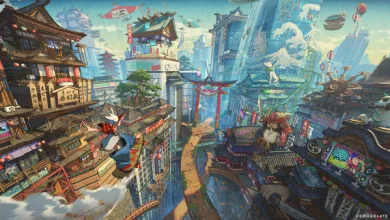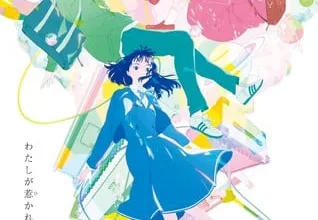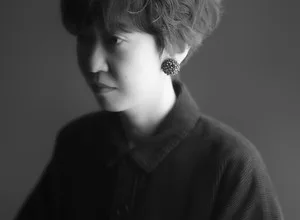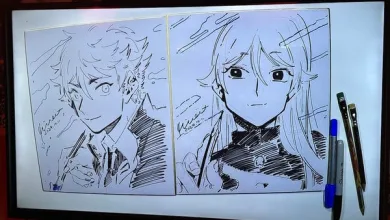Look Back: Director Oshiyama’s Inherent Need to Draw
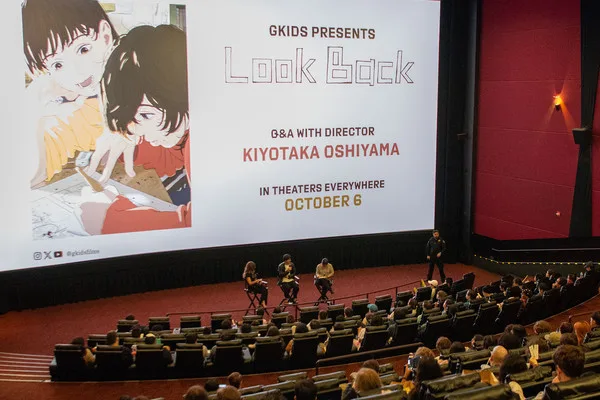
Studio Durian‘s movie adaptation of Tatsuki Fujimoto‘s one-shot, Look Back, has been the talk of the town. Following critical acclaim from some of the most influential Japanese moviegoers, US fans had the chance to see the movie with Director Oshiyama. GKIDS hosted three public screenings, which included a live Q&A with the Look Back director, at the AMC Burbank 16 theater on Friday and Saturday. Prior to the screenings, ANN caught up with Oshiyama on the movie’s success, the immense work of his staff, and what keeps moviegoers coming back to see the movie again and again.
At the live Q&A panels, Oshiyama shared how he became a part of this project, its music, and future plans for Studio Durian. Unfortunately for Goodbye, Eri fans, Oshiyama dashed any hopes of his studio working on that adaptation. “Fujimoto-sensei has a lot of other works, like Goodbye, Eri, but I have no plans to adapt his works again,” said the director at the Saturday night Q&A. “It’s not like I don’t like him or anything, but especially with Goodbye, Eri, I really don’t think it matches my style. I know it’s going be hell to work on.”
Recently, news of his intense work schedule and workload piqued the attention of animation fans. To Oshiyama, wearing many hats was crucial to delivering his vision. “I ended up taking on a lot of work, but I was able to incorporate more of my animator style in this commercial work.” As the subject of Look Back is to highlight the creators, he believed the message matched his style. However, he spent the last week of production drawing “1,000 key animations.” Usually the key animator draws the main frame, and in-between animators would trace over it. The final product would be a cleaned up version of the original key scene. “I wanted to keep more of that key animation; I wanted to keep the raw lines of the animator drawing with their emotion that they’re drawing it.” Keeping the rough, sketchy lines was integral to his vision.
He had his work cut out for him with Look Back alone, self reporting how he worked on 1,000 key animations by himself. The scene where Fujino skips in the rain is one of his favorites, but that one cut took 195 pages of art—which was just the character without any scenery. “When Fujino is running, you can see a white line on her skirt. I forgot to draw that in, so I had to go back and fix every single one. That alone just took a few hours.” Since he animated that scene, he explained how he had to move exactly like her. “I usually don’t exercise at all but I had to make sure the hands and feet were going in a certain way. I had to film myself over and over and then draw it.” Oshiyama swears the footage of him skipping will never see the light of day.
During ANN’s interview with Oshiyama, he talked about the personal aspects of creating a film so near and dear to him and his team.
© Courtesy of GKIDS/Avex Pictures
What does the domestic and international success of Look Back mean to you as the director and as the CEO of Studio Durian?
Oshiyama: I was very lucky. In animation, whether it’s a TV series or a film, all the creators work hard. It’s not something that anybody could do alone. Sometimes things may go as well as you want it to, and sometimes it doesn’t. We worked so hard on this film, and it was able to reach a lot of people who enjoyed it. I think that’s very, very fortunate for us.
Both regular fans and industry professionals like Hideo Kojima have praised your movie. Has there been anything they’ve said that took you by surprise? Or made you think differently?
Oshiyama: When famous people like the movie, it’s great because it’s good PR for us. But whether they’re famous or not, it makes me happy to hear they enjoyed it. Some people will say, “I like this part of the movie. I like that part of the movie,” which makes me happy too. But what really makes me happy is a vague reaction like, “Oh, I just watched a movie. I couldn’t stand up.” Or “it’s making me think a certain way.” That’s what makes me happiest.
You mentioned you worked on the movie up until the last minute, you took on many roles (director, animation director, key animation, etc.), and didn’t leave the office for two and a half months. At first glance, this would be considered an unhealthy work environment. However, you put together a team to make this movie. Why did you decide to take on so much work by yourself?
Oshiyama: When I founded Studio Durian, I wanted to be selfish, and I think that’s really my personality. As in, I wanted to be involved in a lot of things. This is an adaptation of a manga, and [Tatsuki Fujimoto] probably projected the essence of being a manga artist into it. I do think that it was a ‘selfishly’ drawn manga to begin with. To make this film into an anime film, I wanted to selfishly incorporate myself into Look Back. In adapting this film, I reflected and thought about how I can face this story or face this in a way similar to how Fujimoto did when he drew the manga.
This is actually my first time adapting a manga or novel. I really wanted to discover things about myself. I thought, “How much can I relate to the story?” This is really important when adapting something. How would I adapt this film as I’m working on it? I had to relate to the story. Judging from the audience reactions, the film came out pretty true to the manga. But then I actually did project myself as an animator to this film.
I create anime similarly to how Fujimoto creates manga. It was really easy to project myself onto this film, as the subject of the story really matched my personality.
In the trailers and in the movie, Fujino questions herself, asking “What am I doing?” Did you ever have the same thought when you worked on the movie?
Oshiyama: As an animator, that’s something you think about everyday when you’re indoors drawing all day long. When I’m not busy working on anime, I think about how I should go outside, get sunshine, and live like a human. Even so, I have to keep drawing, which is something I feel from within.
Aside from the animation, how involved were you in the soundtrack for Look Back? Listening to “Light Song” in the trailer alone moves me to tears.
Oshiyama: Once the storyboard was almost done, I made a reel of it like a video storyboard. Then I included my own music, like the kind of music that I wanted within the video before turning that to Mr. Nakamura. I talked to the sound director to come up with a list of things that we wanted for each scene, each moment, and turn that in ahead of our meeting with Mr. Nakamura.
Once he took in everything that we asked of him, he came up with musical sound bites. Little by little, as time progressed, the atmosphere was set, and then we added more music and incorporated those.
This movie has been highly anticipated in North America after Look Back‘s positive reviews and incredible box office performance in Japan, with some people watching it multiple times. What do you think attracts people to come back and watch the movie again and again in Japan?
Oshiyama: Since the movie is only around 60 minutes, it’s easy to watch over and over time wise. There’s also very little dialogue in the movie. Most of it is music and scenery, and the element of calm is prevalent throughout the movie. It’s not very visually noisy and is easy on the eyes to watch scenery.
It’s a tear inducing film, and we purposely made it so people would cry. Everyone in Japan is tired and they can use a good cry to escape from the stress of everyday life. Maybe they come to just escape and release their stress.
The story can be interpreted in a few ways, which also adds to the levels of it. People have to watch it to understand all of the levels. We put in a lot of details in the films, like, Easter eggs. You have to watch it many times to discover them.
Although the other members of Studio Durian who worked on the movie couldn’t be here with you, is there anything you’d like to share on their behalf?
Oshiyama: The staff see a lot of the reactions from the people around them. I would like to show them the overseas reactions as well. I have staff who are saying they were glad to be involved with Look Back. I also felt bad for the longest time because I did take their time. I got them involved and sucked them into this project. I’m really happy that they feel we’re glad to be a part of it. In general, in Japan, creators suffer and go through a lot of suffering even for this project. It wasn’t easy at all. If Studio Durian is able to make a lot of money, I would like to give back to them.
I have a lot of reasons as to why I wanted to have a small team. The biggest factor is the quality control. The more staff you have, the harder it is to control quality. It’s also very inefficient as you will inevitably have animators who won’t understand the story or the style, etc.
The more staff you have, the more the main staff has to fix what they’re doing. With Studio Durian, because it’s my studio, I really wanted to keep it this way. I want to have a small team, keep a minimal production team to have compact outputs of what we make. Because this story is about manga, manga is done within a small team, so I wanted to keep the experience close. Creating manga and creating this movie were quite similar.
I want to only use good people, but then of course, those good people are all popular. It’s very hard to get them because of their schedules. We also can’t really use money to lure them in to work on the project. It’s really about the relationships that I’ve had before. I did hire a few new people as well, just so that we create future relationships from there.
Source link
#Director #Oshiyamas #Inherent #Draw

